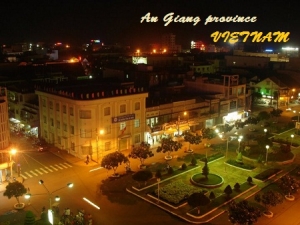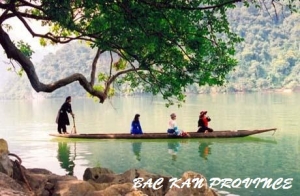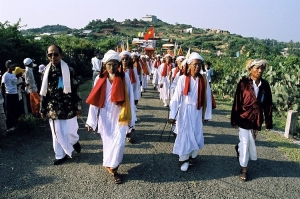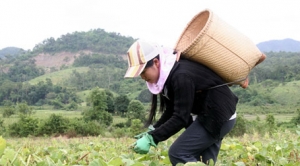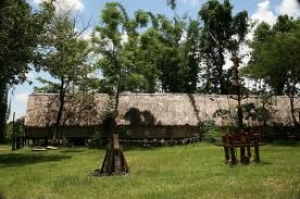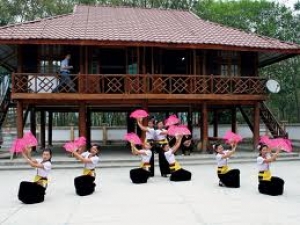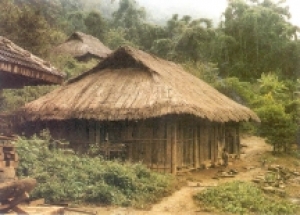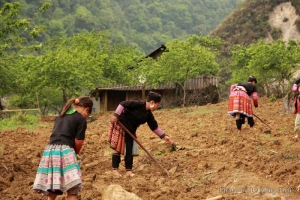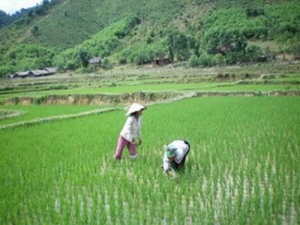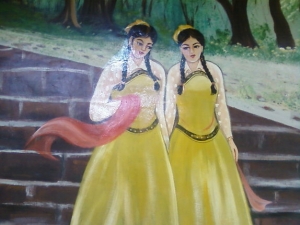
Asia Pacific Travel Team
AN GIANG PROVINCE
Square: 3536,8 km2
Population: 2149,5 thousands people (2010)
City: Long Xuyen City.
Town: Chau Doc.
Districts: An Phu, Tan Chau, Phu Tan, Chau Phu, Tinh Bien, Tri Ton, Cho Moi, Chau Thanh, Thoai Son.
OVERVIEW:
An Giang is located west of the Mekong Delta between the Tien Giang and Hau Giang Rivers and shares a 95-km border with Cambodia. It is next to the Cuu Long River and consists of a few midland areas and low mountains.
The main ethnic groups found in the province are the Kinh, Khmer, Cham, and Hoa. The region is located in a monsoon tropical climate where the annual average temperature varies between 26 and 28°C. The two distinct seasons are the dry season, from December to April, and the rainy season, from May to November. Floods often occur from the middle of August to the middle of November.
An Giang is criss-crossed by many rivers and canals which make a convenient water transport system. The two tributaries of the Mekong river, the Tien and the Hau, run across the province. They deliver millions of cubic meters of alluvium annually to the region. As a result, the deposits have formed several islets which are extremely fertile and covered with lush green vegetation.
An Giang is the location where many relics belonging to the Oc Eo Civilization have been excavated. Many archaeologists have concluded that An Giang was the location of a bustling commercial sea port built with many major architectural projects which can be traced back to the first century. This conclusion has glorified the province as a one time economically and culturally prosperous locality.
An Giang has long been famous for its traditional occupation of mulberry growing, silkworm raising and silk weaving. Famous sites and attractions include An Giang Museum in Long Xuyen, Ba Sam Temple Festival at Sam Mountain in Chau Doc, and Cam Mountain in Binh Tien.
GEOGRAPHY:
An Giang Province is located to the west of the Mekong Delta between the Tien and Hau rivers and shares a 100km border with Cambodia in the north - west. It also shares border with Dong Thap Province in the east, Cantho City in the south - east, and Kien Giang Province in the south - west.
An Giang has two main types of topography: midland areas and low mountains. The low mountains is Bay Nui (Seven Mountains) in Tinh Bien and Tri Ton districts. Vinh Te Tunnel runs along with the province's border in the west, which connects from Chau Doc to Ha Tien.
CLIMATE:
An Giang is divided into two seasons: the rain (from May to November), and the dry (from December to April next year). The annual average temperature varies 27ºC. The highest temperature is 35ºC - 37ºC from April to May and the lowest ones is 20ºC - 21ºC from December to January next year. The annual rainfall is 1,400 - 1,500mm.
TOURISM:
An Giang is main province in rice output. The province also has corn and aquatic products as basa fish, shrimp, cuttle... An Giang is also renowned as traditional handicraft such as Tan Chau silk, Chau Doc fish sauce and other consume products. Especially, long-standing handicraft weaves fabric industry of Cham ethnic group.
An Giang is famous for particular festivals as Ba Chua Xu, Chol Chnam Thomay, Dolta festival and ox racing. Other famous sites and attractions include Sam Mountain in Chau Doc, Cam Mountain in Tien Binh, Tuc Dup Hill, grottoes network of Thuy Dai Son, Anh Vu Son, Co To, and many historical vestiges.
TRANSPORTATION:
An Giang has a relatively convenient land and water transport system. National Road 91 connects to Cam-pu-chia. Buses run from Chau Doc to Long Xuyen, Cantho, and other destinations in the Mekong Delta.
Long Xuyen City is 62km from Cantho, 125km from My Tho, and 190km from Ho Chi Minh City. Chau Doc Town is 96km from Ha Tien, 117km from Cantho, 179km from My Tho, and 245km from Ho Chi Minh City.
Bac Kan
Square: 4859,4 km2
Population: 296,5 thousands people (2010)
Districts: Bac Can Town, Ba Be, Ngan Son, Cho Don, Na Ri, Cho Moi, Bach Thong, Pac Nam
OVERVIEW:
Bac Kan, also spelt as Bac Can, is a province of Vietnam. It is located in the northeastern part of the country, due north of the capital Hanoi. Bắc Kạn is the only town of the province which is the capital of the province and is a municipality. The province covers an area of 4859.4 square kilometres and as of 2010 it had a population of 296,5 thousands people.
GEOGRAPHY:
Bac Kan is a mountainous terrain with rich natural resources of minerals and forests. It has numerous mountains, rivers and lakes which are very scenic; Ba Be National Park and the Ba Be Lake within its precincts are popular attractions.
Bac Kan is a mountainous province, sharing its border with Cao Bang Province to the north, Tuyen Quang Province to the west, Lang Son Province to the south-east, and Thai Nguyen Province to the south. The topography is mainly midland, mountainous. The province has a complex network of rivers and springs.
CLIMATE:
There are two seasons: dry and cold lasts from April to October and hot and rainy from November to December. The cold season lasts longer in the north region. The annual average temperature is 25oC. The annual rainfall is about 1,400mm- 1,800mm. The weather has drizzling rain and high humidity in March, April and August.
TOURISM:
Bac Can has natural of mineral and forest, especially primitive forests with rich of flora and faune. Aside that, natural gives the province many interesting sights such as Ba Be National Park, Dau Dang Waterfall, Ba Be Lake, Puong Cave. Bac Can used to be a cradle of Vietnam revolution so it has many revolutionary relics as ATK in there.
Bac Can is famous for Ba Be Lake Spring Festival with many rituals and activities as boat racing, wrestling, dancing, nem con (con throwing). The festival attracts a lot of people around the region.
TRANSPORTATION:
Bac Can Town is 166km from Hanoi. It is located on the Hanoi - Cao Bang inter-provincial No. 3
Cho Ro ethnic group - The ethnic group has diffirent community organization
Population: 22,567 people (Year 1999)
Locality: Dong Nai, Binh Thuan, Binh Phuoc and Binh Duong provinces.
Customs and habits: The Cho Ro lives in houses built on stilts and on the ground. Both patriarchal and matriarchal customs have significance in the family life of the Cho Ro. The Cho Ro believes that all things have souls and spirits. These spirits have an invisible control over humans which forces them to become involved in worshipping rituals and puts special taboos on them. The most important worshipping ritual is the one that pays respect to the souls of the forest and the rice plant.
Culture: Cho Ro language belongs to the Mon-Khmer Group and has close ties to the Ma and the Xtieng languages. Their musical instruments are comprised of a set of seven-pattern gongs, string instruments with a bamboo sound-box, and alternating songs.
Costumes: The Cho Ro has adopted the Kinh style of dress. The women wear necklaces and bracelets made of copper, silver, or beads.
Economy: The main economic activity practiced is slash-and-burn cultivation. In certain places, rice cultivation in submerged fields has been developed. Animal husbandry, hunting, gathering, fishing, basketry, and wood carving are other sideline occupations.
Chu Ru ethnic group and unique cultural characteristics
Name of ethnic group: Chu Ru (Cho Ru and Ru)
Population: 14,978 people (Year 1999)
Locality: Don Duong District in Lam Dong Province and Binh Thuan Province.
Customs and habits: The Chu Ru worship their ancestors and these rituals are carried out in the cemetery. Each family in the Chu Ru clan consists of three to four matrilineal generations, and monogamy is observed in Chu Ru society. Young women choose their husbands and initiate the process of marriage. The husband then lives with his wife's family.
Culture: The Chu Ru language belongs to the Malayo-Polynesian group. They have adopted a sedentary life and have developed a rich oral literature composed of popular songs, folk songs, and proverbs. The "play" (village) contains many family lineages, and other ethnic groups may reside in the same village. "Poplay" (village chiefs) are elected by the inhabitants of the village and a sorcerer.
Economy: The Chu Ru developed farming practices very early in the culture. They also developed agriculture, raised cattle, made bamboo and rattan articles, and sculpted pottery. Hunting and gathering have now become sideline occupations in every family
Anak Ede ethic group - The ethnic group of famous epics and myths
Proper name: Anak Ede
Other names: Anak, Ea De, Ra De (or Kha De), E De, Egar, De.
Population: 194, 710 people
Local groups: Kpa, adham, Krung, Mdur, Ktul, Dlie, Hrue, Bih, Blo, Kah, Kdrao, Dong Kay, Dong Mak, Ening, Arul, Hwing, Ktle, Epan…
Language: The Ede language belongs to the Malayo-Polynesian group (Austronesia language family).
History: The Ede have long lived in the Tay Nguyen or high plateau region of central Vietnam. Traces of their origin are reflected in their epic poems, their architecture, and their popular arts. Up to today, the Ede community remains a society imprinted with matrilineal traditions.
Production activities: The Ede’s principal food crop is rice, cultivated on swidden fields which, after a period of time, after left fallow before being exploited anew (cleared and burned). Each period of exploitation of a field varied between 5 and 8 years, based on the quality of the soil. Crop rotation and intercropping is practiced and there is only one wet rice harvest per year. Wet rice fields are found only among the Bih near Lac Lake.
The most numerous animals and poultry raised on the family farm are pigs, buffaloes, and chickens, but they are mostly used when there are ritual sacrifices to perform. The most widespread family handicrafts are the plaiting of household objects out of bamboo, the cultivation of cotton in order to weave cloths with the aid of looms similar to those found in Indonesia. Pottery and blacksmithing are not well-developed among the Ede. Barter was the most spread marketing practice in the former time.
Diet: The Ede eat rice cooked in clay pots or in large-sized metal pots. Ede food includes a spicy salt, game meat, bamboo shoots, vegetables and root crops abstained from hunting and gathering activities. Ruou can, fermented alcohol consumed using a bamboo drinking tube or straw, is stored and served in large earthen jars. Steamed sticky rice is reversed for ritual occasions. Men and women chew betel nut.
Clothing: Women wear a long cloth wrapper or sarong which reaches to the toes; their torso may remain unclothed or they may wear a short pullover vest. Men wear the loin cloth and a vest of the same style. When they are cold, men and wears wrap themselves in blankets. Ede jewelry includes glass beaded necklaces, rings made of copper or nickel that are worn around the neck, wrists, and ankles. Men are women alike have their teeth filed, blacken their teeth, and prefer distended earlobes. Head coverings include the turban and the conical hat.
Housing: The Ede primarily live in Dac Lac province, the south of Gia Lai province, and the west of Phu Yen and Khanh Hoa provinces. The traditional Ede house is a construction whose length is reminiscent of the shape of a boat which is cut lengthwise or across giving it a shape of a reversed trapezoid. The structure rests on two rows of columns and not on the ground. The interior space is divided into two parts along the length. The first section is called Gah; it is both the reception area of the large matrilineal extended family. The other part, ok, is divided into many small rooms, each of which is reserved for a couple in the extended family.
Transportation: The plaited carrying basket with two shoulder straps remains the principal way for the Ede to carry their goods. In the Krong Buk region, the footed basket is the most widely used, but not all that popular nowadays.
Social organization: The Ede family is matrilineal: marriage is matrilocal, the children carry the name of the mother’s family, and the youngest daughter is the inheritor. Ede society is regulated by customary laws based on the matriarchal system. The community is divided into two lineages in order to facilitate marriage exchanges. The village is called buon and constitutes a unique kind of habitat. The inhabitants of the buon can belong to many branches of the two lineages, but there is also a nuclear branch. The head of village is the po pom ea or the master of the place of water. He directs, in the name of his wife, the affairs of the community.
Marriage: It is the women who take the initiative in matrimonial relations. She chooses the intermediary in order to ask for a young man in marriage, and once the couple marries, they live with the wife’s family. If one of the couple dies, the family of the deceased’s lineage must replace the spouse according to the chue nue (continuing the line) custom so that the surviving spouse is not alone. It also ensures that the thread of love tied between the two lineages, Nie and Mlo, do not rupture-in conformity to the teachings of the ancestors.
Funerals: The chue nue must be observed for each death. In the case of the death of old age or sickness, the funerals are organized at the home before the burial at the cemetery. In the past, if the people of one lineage died on dates near to those of the death of the same lineage, the deceased would be buried in the same grave. Consider that the other world is a reincarnation of the present world, the Ede share the deceased’s goods and dispose of them in the funerary structure. From the time that the funerary house is made, the celebration of the abandonment of the tomb takes place to put an end to the cares to the soul of the deceased and to his tomb.
New house: The construction of a new h is of interest to the entire village. Villagers help bringing material (wood, bamboo, straw) or help with manual labor in a system of exchanging labor (called H’rim Zit). The inauguration of the new house will take place when one has finished planting a row of trees along the wall. However, one can move well in advances of this date if the condition is not organized for the inauguration. Women, led by a khoa sang – the female head of the matrilineal family are the first ones authorized on walk on the new floor. They carry with them water and a fire in order to give coolness and heat to the new house. It is an Ede way to wish happiness on the members of the new house.
Festivals: Festivals are celebrated in the course of the last month of the lunar year, after the harvest time. After the festival of the new rice, h’ma ngat, it is the festival mnam thun, in honor of an abundant crop. It is the largest of the year, with wealthy people killing a buffalo or an ox as an offering, and others offering a pig or poultry. The spiritthe most important is Ae Die and Ae Du, the Creator, followed by the spirit of rice, yang mdie, and others. The Ede are animists. The agricultural spirit is the good spirits, while thunder, lightning, whirlwinds, tempests, and floods are the bad spirits. There are rituals that follow the course of a person’s life, rites that ask for happiness and health. The more rites there are, and especially those with the sacrifice of many buffaloes and oxen and great quantities of jars (for the fermentation of alcohol), the more the organizer are held in esteem by the villagers.
Calendar: The traditional agricultural calendar is fixed to the evolution of the moon. The 12-month year is divided into 9 periods corresponding to the 9 steps of agricultural work: clearing the fields, burning the vegetation, turning over the soil, wedding…each month is comprised of 30 days.
Education: Apprenticeship to a trade or craft and the dissemination, and oral transmission. Ede writing based on Latin script made its appearance in 1923.
Artistic activities: The khan is a long epic poem that one recounts in vivid exclamations and illustrates with gestures. There are alternating songs, riddles, genealogical histories…In addition, Ede literature is famous for unique myths, legend, folklores...Ede music is celebrated by the ensemble of 6 flat gongs, 3 gongs with projections, a gong for rhythm, and a drum. The gongs would never be absent from a festival or a cultural activity. Aside from the gongs, there are bamboo instruments and calabashes resembling those of other Ethnic groups in the Tay Nguyen region, though they are distinctively Ede.
Entertainment: Children like spinning top, kite flying, and flute playing. Stilt-walking is enjoyed by many. Hide and seek and lance or javelin throwing at a target are also currently enjoyed.
The Thai ethnic group with the charming beauty
Proper name: Tay or Thay
Other name: Tay Thanh, Man Thanh, Tay Muoi, Tay Muong, Hang Tong, Tay Do and Tho
Population: 1,040,549 people
Local groups: Black Thai (or Tay Dan) and White Thai (Tay Don or Khao)
Language: Thai language belongs to the Tay-Thai group (of the Tai-Kadai language family)
History: The Thai originated from inland Southeast Asia where their ancestors have lived ancient times.
Production activities: Early in their history, the Thai adopted wet rice cultivation, using suitable irrational networks. The work can be summarized in the Thai saying “muong-phat-lai-lin” (which means digging of canals, consolidating of banks, guiding water through obstacles, and fixing water gutters) in the fields. While the Thai once grew only one sticky rice crop a year, nowadays they have converted to two crops of ordinary rice. They also cultivate swidden fields, where they grow rice, corn, and subsidiary crops, especially cotton, indigo and mulberry for cloth weaving.
Diet: Today, ordinary rice has become the main food of the Thai, while sticky rice is still being eaten traditionally. Sticky rice is steeped in water, put in a steaming pot and put on a fire and cooked. A meal can not go without ground chili mixed with salt and accompanied by mini, coriander, leaves and onion. Boiled chicken liver, fish gut, and smoked fish called cheo could be well be added to the meal. Ruminate meat should be accompanied by sauce taken from the internal organs (nam pia). Raw fish should be either cooked into salad (nom) or meat-in-sauce (nhung), or sauced. Cooked food processing ranges from roasting, steaming and drying to condensing, frying, and boiling. The Thai enjoy foods with more hot, salty, acrid and buttery tastes, in contrast to those that have sweet, rich and strong tastes. They smoke with bamboo pipes, lighted by dried bamboo pieces. Before smoking, the Thai maintain their custom of hospitality by inviting others to join in, much as they would do before a meal.Clothing: Thai women are beautifully adorned in short and colorful blouses, accented down the front with lines of silver buttons in the shapes of butterflies, spiders and cicadas. Their blouses fit beautifully with their tube-shaped black skirts. The bell is a green colored silk band. They wear a key chain round their waists. On Festivals occasions, Thai women can wear extra black dress, with an underarm seam or like a pullover which has an open collar, thus revealing the silver buttons inside. The black dresses are nipped at the waist; include large shoulders and decorative pieces of cloth that are attached to the underarms or to the front of the shoulders in a manner similar to the White Thai. Black Thai women wear the famous pieu shawl with colorful embroidery. Thai men wear shorts with a belt; a shirt with an open collar and two pockets on either side. White Thai men have an additional upper pocket on the left and their collar is fastened with a cloth band. The popular color of all clothes is black, pale red, stripped or white colored.
On Festivals people wears long black dresses, with split underarm seams and an internal white blouse. A head turban is worn as a headdress, around the carrier’s forehead; at times, pack horses are used. Along large rivers, the Thai are famous for transporting goods and people using swallow-tailed boats.
Social organization: The original social structure is called ban muong, also known as the phia tao regime. The Thai lineage is called Dam. Each person has three key lineal relationships: Ai Noong (every born from a common fourth-generation ancestor); Lung Tay (every male member of the wife’s family throughout generations); and Nhinh Xao (every male member of the son-in-laws)
Marriage: In the past, the Thai respected the selling and buying of marriage and the son-in-law’s staying with the girl’s family. To marry a husband, the girl’s family needs to take two basic steps:
Up marriage (dong khun) – means the introduction and bringing of the son-in-law to live with the girl’s family, which is a step to test his personality and hard work. The Black Thai women generally adopt the custom of wearing their hair in as bun or chignon immediately after this first wedding ceremony. The son-in-law will stay at his wife’s home for 8 to 12 years.
Down marriage (dong long) – the bringing of the couple and their family.
Birth: Women give birth in the seated position. The placenta is put into a bamboo cylinder and hung on a branch in the forest. The mother is warmed by fire, fed rice using a bamboo tube, and must abstain from certain foods for a month. The bamboo tubes are hung on a tree branch. There are rituals to educate the child in gender-specific work and a Lung Tay is invited to the house to name the baby.
Funerals: Basically, there are two steps in a funeral:
- Pong: the bringing of offerings o the deceased and bringing the deceased to the forest for burial (White Thai)
- Xong: Calling the spirit to come back and live in the section of the house reserved for the worshipping of ancestors.
New House: Showing the host his new house, the Lung Ta kindles a new fire. In celebrating a new house, people carry out spiritual rites on the spot, readingspiritual texts to drive away bad lucks and to bring good lucks, and to worship ancestors.
Festivals: The Black Thai worship their ancestors on the 7th and 8th month of the Lunar Year. The White Thai also celebrate the New Year according to the lunar calendar. Villagers also worship the gods of land, mountain, water and the soul of the central post of the village.
Calendar: The Thai calendar follows the ancient horoscope or cosmology (which contains 12 key animals) like the lunar calendar. But the Black Thai’s calendar has a time difference of six months.
Education: The Thai have their own Sanskirt-style writing system. Their language is taught orally. The Thai have many ancient written works on their history, traditions, customary laws, and literature.
Artistic activities: The Thai perform their xoe dance and play many kinds of flutes. They sing out verses and vivid alternate songs.
Entertainment: Thai popular games include con throwing, tug-of-war, horse racing, boat cruising, archery, xoe dance, spinning top, and mak le balls. There are many other folk games for kids.
Dao ethnic group and the special traditional customs
Proper name: Kim Mien, Kim Mun (jungle people)
Other names: Man
Population: 473,945 people
Local groups: Dao Do or Red Dao (Dao Coc ngang, Dao sung, Dao Du lay, Dao Dai Ban), Dao Quan Chet or Dao with tied or belted trousers. (Dao Son Dau, Dao Tam Dao, Dao Nga Hoang, Du Cun), Dao Lo gang (Dao Thanh phan, Dao Coc Mun), Dao Tien or Dao with silver coins or money (Dao Deo tien, Dao Tieu ban), Dao Quant rang or Dao with white trousers (Dao House), Dao Thanh Y or Dao with blue vest, Dao Lan Ten (Dao Tuyen, Dao Ao dai or Dao with long tunics).
Language: The Dao language belongs to the language family of Hmong-Dao.
History: Dao people originally came from China, immigrating between the 12th or 13th century and the early 20th century. They claim themselves descendants of Ban House (Ban vuong), a famous and holy legendary personality.
Production activities: Dao communities cultivate swidden fields, rocky hollows, and wet -rice paddies. These cultivation activities play a dominant role among different groups and areas. Dao Quan Trang (white trousers) people, Dao Ao Dai (long tunic) and Dao Thanh Y (blue clothes) specialize in wet-rice cultivation. Dao Do (Red Dao) people mostly cultivate in rocky hollows. Other Dao groups are nomadic, others are settled agriculturists. Popular crops are rice, corn and vegetables, such as gourds, pumpkins, and sweet potatoes. They raise buffaloes, cows, pigs, chickens, horses, goats in the middle regions of mountains and highland areas.
Cotton farming and weaving are popular among the Dao groups. They prefer garments dyed indigo. Most village wards have forge kilns serving for farming tools repairing. In some places, people make matchlock and flint-lock rifles and cast-iron bullets. The silversmith trade, handed down through generations, mostly produces necklaces, earrings, rings, silvers chains, and betel nut boxes.
Dao Do (Red Dao) and Dao Tien (Coin or Money) groups are well-known makers of traditional paper. The paper is used when writing history, story and song books, when making petitions, when sending money for funeral services, and on other occasions. Other Dao groups are noted for pressing certain fruits to extract oils which they use to illuminate their lamps. Sugarcane is also refined.
Diet: Dao people have two main meals a day-lunch and dinner. Breakfast is eaten only during the busy harvesting season. The Dao eat mostly rice. However, in some places, people eat corn or soup instead of rice. Popular rice meal is made of wood and bamboo. Mortars are divided into several types, such as pillar-shaped mortars or water sprout mortars, with rice-pounding pestles controlled by hands or feet or by water power. The Dao prefer boiled meat, dried or sour mixed meat and sour bamboo shoot soup. When eating is finished, the Dao have a tradition that they never put down the chopsticks on the bowl because it signifies that there is a death in the family. Dao people usually drink distilled alcohol. In some places, they drink a kind of local wine, having a slightly sour and hot taste. Dao people smoke cigarettes or locally grown tobacco with pipes.
Clothing: In the past, men had long hair with chignon or top tuft, with the rest shaved smoothly. Different groups have different types of head-scarves and ways of wearing them. They wear short or long shirts.
 Dao women’s clothes are diverse. They usually wear a long blouse with a dress or trousers. Their clothes are colorfully embroidered. When embroidering, they create designs based on their memories. They embroider on one side of the cloth so that the design is seen on the other side. They have several designs such as the letter “van”, the pine tree, animals, birds, humans, and leaves. Their method of creating batik garment is unique. They put the batik stylus or pen into hot bee’s wax and then draw the design onto the cloth. The portion of the cloth receiving the waxed patterns resists the indigo blue dyeing a cloth of beautiful blue and white patterns.
Dao women’s clothes are diverse. They usually wear a long blouse with a dress or trousers. Their clothes are colorfully embroidered. When embroidering, they create designs based on their memories. They embroider on one side of the cloth so that the design is seen on the other side. They have several designs such as the letter “van”, the pine tree, animals, birds, humans, and leaves. Their method of creating batik garment is unique. They put the batik stylus or pen into hot bee’s wax and then draw the design onto the cloth. The portion of the cloth receiving the waxed patterns resists the indigo blue dyeing a cloth of beautiful blue and white patterns.
Housing: Many Dao communities are found about half-way up most of the northern mountainous regions. However, there are several Dao groups that live in valleys, such as the Dao Quan Trang (white trousers), as well as high-mountain dwellers like the Dao Do (Red Dao). Wards and houses are scattered around. There are a variety of architectural styles, as some Dao build their houses directly on the ground while others build them on stilts. Some Dao houses combine both these elements.
Transportation: Dao people in highland areas use black baskets with two straps to transport goods and produce. Those living in the lower elevantor carry goods with a pair of containers suspended on each end of a carrying pole that rests on the shoulders. Cotton bags or net bags or net back-packs are preferred here.
Social organization: Village relationships are essentially regulated by parentage or by being neighbors. The Dao people have many family surnames, the most popular being Ban, Trieu. Each lineage or each branch possesses its own genealogical register and a system of different middle names to distinguish people of different generations.
Birth: Dao women give birth to their children in the seated position, and usually in the bedroom. The newborn is given a bath with hot water. The family of the expectant mother usually hangs green tree branches or banana flowers in front of their door to prevent evil spirit from doing harm to the baby. When the baby is three days old, they celebrate a ritual in honor of the mother.
Marriage: Boy and girl who want to get married must have their dates of birth compared and consult with a diviner who interprets their future in a ritual using chicken legs to see if they are a compatible match. During the course of the marriage ceremony, the Dao have the custom of stretching a piece of string in front of the procession, or exchanging songs between the couple’s families before entering the house. When the bride comes to the groom’s house, she is carried on his back, and she must step over a pair of blessed scissors when crossing the threshold into the husband’s home.
Funerals: A men called thay tao plays an important role in the funeral. When there is a death in the family, the deceased’s children will have to invite him to supervise the rituals and fine a piece of land for the grave. Care is taken so that the corpse will not be laid out at the same time someone in the family has been born. The deceased, who may be wrapped in a mat, is placed in the coffin inside the home. Then it is carried to the grave. The grave is built of earth and lined with stones. In some Dao areas, the body is cremated if the deceased is older than 12 years old of age. Funeral rituals celebrated to ensure that the deceased rests in peace may take place mane years after the burial. The ceremony usually coincides with initiation rites (cap sac) for a Dao man of the family. The celebration takes place over the course of three days. The first day liberates the spirit of the deceased, and is likened to a break from jail. On the second day, the deceased is worshiped in the house. Then, on the last day, the man’s initiation rite takes. At this point, a particular rite returns the deceased’s spirit to its homeland, Duong Chau.
Building a New House: the age of different members of the family must be considered before a new house is built. This is especially true in the case of the age of the head of the household. The Dao ritual for selecting the land for a new house is considered very important. It takes place at night and involves digging a hole as big as a bowl, arranging grains of rice to represent people, cows, buffaloes, money, rice, and property. And this is placed into the bowl. Based on the dreams that follow in the night, the family will know whether it is good to build the house. The next morning, the family inspects the hole to see if the rice remains and if it is possible to build the house.
of the head of the household. The Dao ritual for selecting the land for a new house is considered very important. It takes place at night and involves digging a hole as big as a bowl, arranging grains of rice to represent people, cows, buffaloes, money, rice, and property. And this is placed into the bowl. Based on the dreams that follow in the night, the family will know whether it is good to build the house. The next morning, the family inspects the hole to see if the rice remains and if it is possible to build the house.
Beliefs: Dao religious beliefs include traditional practices and agricultural rituals mixed with elements of Confucianism, Buddhism and Taoism. Ban vuong is considered the earliest ancestor of the Dao people, so he is worshiped together with the ancestors of the family. In Dao tradition, all grown-up men must pass an initiation rite, cap sac, which expresses the traits of Taoism and the ancient rituals.
Calendar: Dao people use the lunar calendar for all of their activities.
Education: In most wards, people know Han nom (Chinese) characters and the Dao language. Instruction is necessary for reading the ritual texts, folktales and poems.
Artistic activities: The Dao have a rich folk literature and arts with old stories, songs and verse. The Gourd and the Flood Disaster and the Legend of Ban vuong are particularly popular Dao stories. Dancing and music are performed mostly in religious rituals.
Games: Dao people like playing swings, spinning top, and walking on stilts.
The neglected beauty of H'mong mountain villages
Proper name: Hmong, Na Mieo
Other names: Meo, Mieu Ha, Man Trang
Local groups: White Hmong, Chinese Hmong, Red Hmong, Black Hmong, Green Hmong, Na Mieo.
Population: 558,053 people
Language: The Hmong speak a language that belongs to the Hmong – Dao language family.
Production activities: Farming is done on terraced or swidden fields where corns, rice, and wheat are planted. The farmers inter-plant other crops together with the main product, including such crops as lotus, potato, vegetable, peanut, sesame, beans, etc. The plough of the Hmong is famous for its good quality as well
as its efficiency. Growing flax, poppy (in the past), and fruit trees such as apple, pear, peach, plum, together with weaving flax are distinctive activities of the Hmong. The Hmong raise water buffaloes, cows, pigs, chickens, and horses. The horse is the most effective source of transportation in these mountainous areas, and they are beloved animals of each Hmong family. The Hmong handicraft industry is well-developed with works like embroidery blacksmithing, and the making of horse saddles, wooden furniture, rice paper and silver jewelry. All of the above items are produced according to need. Though the Hmong practice their crafts part-time, their products, such as ploughs, barrels, and wooden furniture are quite famous and well known. Local markets of the Hmong satisfy not only the trading need but also fulfill their other social pursuits as well.
Diet: The Hmong usually eat 2 meals per day, but during harvesting time, they increase to 3 meals per day. There are traditional dishes in a daily meal, like steam corn flour or rice, fried vegetables and soups. The Hmong use wooden spoons to eat the corn flour, and rice on holidays and Festivals. The Hmong like to drink wine made from corn and wine. They smoke tobacco in long pipes. Offering guests pipe which the tobacco is stuffed by the host is an affectionate gesture of hospitality. In the past, smoking opium was fairly popular.
Clothing: Hmong Clothing is rich in color and types. White Hmong women grow flax, and weave it into textiles. They dress in white skirts, and buttoned shirts  ornamented with embroidery patterns on the sleeves and back. They shave some of their hair, and wrap a long scarf around their head. Chinese Hmong women wear indigo skirts with a flower patterns embroidery design. They wear quilted tops which split above the under arm. Hmong women wear their hair long, and wrapped in a bunch affixed with a twig. Black Hmong wear skirts made from indigo, ornamented with batik flower-patterns, and buttoned shirts. Green Hmong women wear long wrapped skirts. Those who are married arrange their hair in a chignon or bun on the top of their head, and fastened with a little bone or animal hoof comb. On top of that, they wear a scarf that is tied in the shape of two horns. The main decorations on their dresses are made by quilting and embroidery.
ornamented with embroidery patterns on the sleeves and back. They shave some of their hair, and wrap a long scarf around their head. Chinese Hmong women wear indigo skirts with a flower patterns embroidery design. They wear quilted tops which split above the under arm. Hmong women wear their hair long, and wrapped in a bunch affixed with a twig. Black Hmong wear skirts made from indigo, ornamented with batik flower-patterns, and buttoned shirts. Green Hmong women wear long wrapped skirts. Those who are married arrange their hair in a chignon or bun on the top of their head, and fastened with a little bone or animal hoof comb. On top of that, they wear a scarf that is tied in the shape of two horns. The main decorations on their dresses are made by quilting and embroidery.
Housing: The Hmong live gathered in villages, each one composed of several dozen households. Their houses are one story, with 3 rooms, 2 wings, and 2 or 3 doors. The family altar is located in the middle room. The houses of well-to-do families may be decorated with wallpaper, have wooden columns placed on pumpkin-shaped stone, tiled roof, and wooden floors. The altar is placed in the middle room. More typical, though, are houses made with bamboo walls and straw roofs. Food-staffs are stored on high shelves. In some places, there are food storage areas right next to residential houses. Cattle barns are paved with planks, and are high and clean. In high mountainous areas, there is often a big space between two houses, and there are 2-meter-tall stone walls to separate them.
Transportation: The Hmong use horses for transportation. They use carrying baskets that have two handles.
Social organization: There are many skin lines in a village, and several prominent lines that tend to play a more decisive role in the village’s social structure. The head of the village takes care of all the disputes, either by fine or by social pressure. Inhabitants of each village voluntarily follow its rule in agricultural production, cattle raising, forest protection, and more over in helping each other. The Hmong pay a great deal of attention to family branches which share the same ancestors. Each of these has some special traits, which are evident in rituals to honor the ancestors and the spirits, and include how many incense bowls there are, where they are placed, and how to pray. There are also differences in the funeral customs of different branches of a family: where the corpse is placed in the house, how to leave the dead outside before burying, where to locate the graves, etc. People in the same kinship line, though do not necessarily always knows each other, and though they belong to different generations, could still recognize each other by these special customs, it’s a taboo for people in the same family line to marry each other, because those kinsmen are very close. The head of a family tree has much authority, is respected and trusted by every one. The Hmong have small patriarchal families. The bride, once she is introduced in the wedding ritual and walks through her husband’s family’s doorway, is said to completely belong to the husband’s family line. Husbands and wives are very affectionate, and are always side by side; they go to the market, work in the terrace, and visit relatives, etc, together.
Beliefs: There are many sacred places in the house that are reserved specifically for worshiping, such as a place for ancestors, for house spirits, door spirit, and kitchen spirit. Those men who are traditional healers or ritual specialists have altars to worship the founders of their profession, there are many rituals duding which the strangers are forbidden to walk into the Hmong’s houses and villages. After worshiping a spirit to pray for someone, a good-luck charm is worn.
Education: The Hmong writing though edited like the national alphabet since the 60s is no longer widely used today.
Festivals: While the Vietnamese are busy to finish those last days of the year, the Hmong have already started those first days of the next year. Counting by the Vietnamese Lunar Calendar, the Hmong’s New Year is in December to coincide with their traditional agricultural calendar, and it is about one month earlier than the Vietnamese Tet. During the New Year’s Festival, villages play shuttlecock, swing, flute, and sing and dance at public areas around the villages. The second biggest holiday is the 5th of May (lunar calendar). Outside these two, depending on location, some places celebrate the 3rd of March, 13th of June, or 7th of July holidays (of the lunar calendar)
Artistic activities: Young people like to play pan-flutes while dancing. Flutes and drums are also used in funerals, when visiting someone, or during worshipping. Flutes made from leaves and whistles are vehicles for young people to express their feelings.
The Viet ethnic group - The majority ethnic group of Vietnam
Other name: Kinh
Language: The Viet have their own language and writing system. Vietnamese belongs to the Viet-Muong language group (of the Austroasiatic language family).
History: Since ancient times, the ancestors of the Viet had settled in Northern and central Vietnam. Throughout their history, the Viet have played an important of drawing together and uniting all the other Ethnic groups to build up and to protect the nation.
Production activities: Viet agricultural is based on wet rice cultivation, and was developed very early. Through many, many generations of working in the rice fields, the Viet’s ancestors summarized all the experience of what needed for a crop to be successful in just couple of profound words” First water, second fertilizer, third hard work, fourth good seeds.” The grand system of dikes and dams which the Viet have today served as eloquent proof of their forefather’s persistent spirit in conquering hardships to live and to produce. Raising pigs, poultry, birds, and fishing are also fairly developed among the especially precious animal to the farmer. The Viet are renown in producing a wide variety of handicrafts. More than few handicraft villages have [parted from the work of farming. Village markets, fairs, and district markets are very busy. Today, metropolitan areas and industrial sites are developing more and more as the nation industrialized and modernized.
Diet: “Rice, green tea” are said to form the basic everyday food and drink of the Viet people. Sticky rice is only used in Festivals occasions. Fish, vegetable or crab soups often appear as part of the daily meals. The Viet are especially fond of eating sauces made from shrimp, fish and crab, and pickles made from green onions, mustard greens, egg-plant, etc. Sweet soya sauce and other spices like chili, garlic, and ginger are popular. Alcohol is consumed at parties and festival occasions. In the past, eating betel nuts, and smoking tobacco by water pipes were popular, but were also part of Viet customs and rituals.
 Clothing: In the olden days, a Viet man used to wear chan que trousers ( a kind of wide-legged pants that looked like a skirt), with a brown shirt (in the North) or a black shirt (in the South). Traditionally, the Viet did not wear shoes. On special occasions white trousers, a long black shirt, pleated ready-to-wear turban, and wooden sandals were worn. Viet women traditionally black skirts and brown blouses. In the North, they wore black scarves. On Festivals occasions, Viet women wore the traditional ao dai, which have remained popular today. In the winter, both men and women wore double layer cotton jackets.
Clothing: In the olden days, a Viet man used to wear chan que trousers ( a kind of wide-legged pants that looked like a skirt), with a brown shirt (in the North) or a black shirt (in the South). Traditionally, the Viet did not wear shoes. On special occasions white trousers, a long black shirt, pleated ready-to-wear turban, and wooden sandals were worn. Viet women traditionally black skirts and brown blouses. In the North, they wore black scarves. On Festivals occasions, Viet women wore the traditional ao dai, which have remained popular today. In the winter, both men and women wore double layer cotton jackets.Dresses for different ages were distinguished not by style, but usually by different colors and sizes. The quality of textiles distinguished the Clothing of the wealthy from those who were less affluent. Only the wealthy wore jewelry. At the beginning of the century, Viet men in rural areas were seen to wear only loincloths.
Lifestyle: The Viet usually live in one story houses. Their houses were combinations of living quarters-yards-gardens-ponds. The main house used to have from three to five rooms with the middle one being the most important, where the ancestor’s altars were placed. Other areas were places where all family activities and relaxation took place. There were always little wings where the women slept and where foods and family possessions were kept. Kitchens were located nest to pigsties. In many Southern provinces, kitchens were built nest to the main living quarters. Yards, used for drying things, family activities, as well as for relaxing, are well suited to the region’s humid, tropical climate.
Transportation: The Viet transport their goods by road and water, using a variety of methods: - By road: carrying a basket or things on the shoulder using different kinds of carrying poles, such as ganh quang, ganh cap, don ganh, don soc and don can, etc.; carrying items using a stick or don khieng; carrying by a stretcher of mat sacks and sackcloth, pack-saddling goods using bicycles, pull carts, buffalo and ox carts. – By water: using boats, rafts, floats, canoes and ships. Each of these means has different shapes, sizes, materials and devices.
Social organization: The majority of the Viet live in villages. Several villages form a commute district. Many of these communes are actually part of one big village, and smaller villagers may just be split from the main village. There are different hamlets in a village, some are bigger than others. Before the Revolution system-fairly efficient self-ruled, the ruler’s group was called Phe Giap. They united the villagers to take care of all the village’s affairs from managing labors to matters of etiquette to worshiping village’s founders. Handcraft villages organized guilds for each profession. Within a village, the segregation between villagers and outsiders was outlined in its charter. A village’s traditions and customs were highly regarded and every one followed them conscientiously.

Family: Viet families are mostly small, with two generations living together in a patriarchal system. Nevertheless, women still play an important role in managing the family’s economy.
The Viet have numerous family names, and some of the most popular one are Nguyen, Tran, Le, Pham, Vu…, which can be seen everywhere. Each family clan has its own worshiping house. There are many of shoots in a family clan, and there are many branches in an offshoot. Each of these branches includes grandparents, parents, sisters, and brothers. Relations from the father’s side are well-kept from generation to generation. Relatives are close and loving to each other.
Marriage: Loyalty in love is of utmost importance to the Viet. Under feudal rules, parents chose wives and husbands for their children. Nowadays, young men and women are free to choose their life partners. These are the traditional steps which a young Viet couples goes through to become husband and wife:
- Proposing: The groom’s family asks a matchmaker to go to the future bride’s family to propose the marriage.
- Engagement: The groom’s family buys offerings and gifts to bring the bride’s house for official talks with her parents and relatives.
- Wedding: The ancestors are worshipped, gifted are presented to families, relatives and friends of both sides, and the groom comes to take the bride to his home.
- Revisiting: The newly-wed couple revisits the bride’s family. It is only upon completion of all of the above elaborated rituals, and the legal registration, that the young couple then becomes husband and wife.
Funerals: Viet funerals are very solemn, highly ritualized, and include all these steps: shrouding, putting the body in the coffin, saying farewell, lowering the coffin into a grave, food offerings, weekly ritual sacrifices, one hundred days’ ritual, exhumation, etc…Every “Pure Light” day, every Chinese New Year, and every death anniversary, each family visits their loved ones at the grave. The Viet regard exhumation as a very sacred ritual.
New House: There is a popular sentence: “marry a kind wife, build your house facing south.” House that faces the South will be warm in the winter, cool in the summer. When building a new house, besides choosing the right direction, the owner’s age has to be examined to pick out a good date to start construction. Once construction is completed, a good date needs to be selected again to bringing ancestors to the new house, and to celebrate the n ew house.
ew house.
Beliefs: The worshipping of ancestors is the most important practice of the Viet. They usually place the ancestral altar in the grandest place in the house. Rituals are held for every festival occasion, every full moon, and the first day of the lunar month etc. The custom of worshipping the House God and Kitchen God are popular as well. More than a few families worship Buddha and the God of Wealth at home. In every village, there are temples for the founder; pagodas for Buddha, places to worship Confucius, etc…There are sections of the population in both rural and urban areas whom are Catholics, Christian, Caodist, etc…
Festivals: The Chinese or lunar New Year is the biggest holiday of the year, followed by many spring Festivals. There are other festival occasions, though, such as the first full moon of a year, day of “Pure Light”, double Five Festival (on 5th day of the 5th Lunar month), Autumn Festival, etc. Each of these has its own meanings and ceremonial rituals.
Calendar: For a long time, the lunar calendar has been used in the Viet’s lives, customs, and religions. They use it to count age, count death anniversaries, count planning days for crops, count bag and good days for big occasions such as building a house, wedding, funeral, etc. Nevertheless, the Western calendar is the official one, which is used more regularly nowadays.
Education: The Viet have moved from using Chinese and Vietnamese characters to the writing system used today. In the old kingdom of Thang Long (present-day Hanoi), the Ly dynasty had built the Temple of Literature, considered the first national university of Vietnam, to train intellectuals.
Literature and arts: There are rich varieties of folktales and literature such as fairy-tales, folk songs, pop songs, proverb, etc, which reflect the people’s lives. They contribute profoundly to preserving the national character. Written literature had also reaped successes under the Ly and Tran Dynasties. The 15th century gave birth to talented writers such as Nguyen Trai, Nguyen Binh Khiem, House Xuan Huong, etc…Other arts like fine arts, music, and theatre are highly developed and professional.
Entertainment: The Viet have games for different ages, genders, seasons, individuals and groups. There are games that require refined enjoyment such as releasing birds, flying kites, playing chess. There are sporty and communal games like tug-of-war, swings, wrestling, and boat racing. Many games bear the nation’s history and characters such as rice cooking competitions. Children’s games are countless, and differ in each region. Spring Festivals are where traditional games are most prominent.
The Hoa ethnic group
Other names: Khach, Han, Tau.
Population: 900,185 people
Local groups: Quang Dong, Quang Tay, Hai Nam, Trieu Chau, Phuc Kien, Sang Phang, Xia PHong, Thang Nham, Minh Huong, He…
Language: The Hoa or Ethnic Chinese, speak a language belonging to the Chinese, language group (Sino-Tibetan language family).
History: The Hoa have migrated to Vietnam in different periods since the 15th century. Later on, other waves of Hoa immigrants came at the end of the Minh, or beginning of the 20th century.
Production activities: In rural areas, the Hoa live mainly as farmers, who plant rice in wet fields. In urban areas, they are active in trading in service businesses. Handicrafts, such as pottery making, is highly developed (in Quang Ninh, Song Be, Dong Nai provinces), as is paper and incense making (in Ho Chi Minh City). Fishing and salt production are economic of a small group of Hoa who live along the coastline. In business, the Hoa always respect the word “trust”
Diet: Rice is the main food. However, they often eat wanton, rice noodle soup, and stir-fried noodles. In middle class family people eat rice soup with salty duck eggs for breakfast. The Hoa have good cooking techniques. They prefer stir-fried dishes with lots of spices. Hoa drinks, on top of quenching one’s thirst, are also considered as medicine: good for the whole body. Ginseng tea, chrysanthemum tea…are popular drinks in every family. On festival occasions, men like to drink wine. Many people smoke tobacco, including women, especially the elderly ones.
Clothing: Hoa traditional dress can only be seen on old people, or on special occasions like weddings and funerals. Women like to wear a blouse with a high collar, buttoned down along one side, and high cuts along each side panel. The long Hoa dress, tight around the hip, and with high cut panel along one side, is also very popular. Women, especially young ones, like to dress in red, pink or dark colors. The men wear black, or dark green shirts, which have buttons on one side, standing collar, and cut panels on the two sides. The shirt with four laps, standing collar, cut in the middle and with pockets, is also popular for men. The women are fond of jewelry, especially bracelets (made of brass, gold, stone, or jade), earrings, and necklaces. The men like to implant gold teeth as an accessory.
.jpg) Housing: Those who are farmers form their own villages that usually lie on the foothills, on terraces, and along beaches. The above sites have the advantage of being close to water sources, and are convenient for traffic and transportation. In the villages, those who have houses close to each other’s are usually relatives. In urban areas, they form their own Hoa neighborhoods.
Housing: Those who are farmers form their own villages that usually lie on the foothills, on terraces, and along beaches. The above sites have the advantage of being close to water sources, and are convenient for traffic and transportation. In the villages, those who have houses close to each other’s are usually relatives. In urban areas, they form their own Hoa neighborhoods.
There are three kinds of houses: those with 3 rooms and 2 wings, those shaped like a gate, and those with shapes like w mouth. They are usually built from stones and bricks, have earthen wall, and have either tile or thatched roofs. Altars to worship ancestors, Buddha, and God stand out in the Hoa house. Carved wooden couplets or parallel sentences, scrolls, and Chinese calligraphy on pink paper pray for luck, success, and peace and are also popular things to hang in the house.
Social organization: The Hoa are highly patriarchal and there are evident differences between the rich and the poor. Relationships among relatives are very important. Each family tree has an ancestor temple for worshipping. Every year, on a specific day, everyone in the family gets together for the anniversary of their ancestors’ death. Business groups and guilds have the same tradition as well. They all have an ancestor founder and a yearly anniversary day. The Hoa have stable, monogamous marriages, and patriarchal family structure. Marriage usually occurs within people of the same local group. The head of a family line, the matchmaker, and local officials play an important role in a marriage. Today, women get married fairly late (average age is 28, 30), and have fewer children (2 to 3 each family).
Festivals: There are many holidays in a year: the Lunar New Year, the festival of the first moon night of the year Pure Light festival, double Five Festival (on the 5th day of 5th lunar month), all Soul’s Day (15th day of 7th lunar month), mid-autumn festival. The Hoa Lunar New Year lasts from those final days of one year to the 15th of January of the next year (lunar calendar). The festival to celebrate the year’s 1st moon is the most important Hoa event, where prominent religious and traditional cultural activities occur.
Beliefs: Ancestors, family spirits, guardian Gods (kitchen God, land God, and the God of wealth), and Buddha are popular worshipped figures. Pagodas and temples are widely developed. They are also the Hoa’s place for a social headquarters or a school, and where communal activities and Festivals take place.
Education: The Chinese language is taught and studied in grade school.
Artistic activities: The Hoa have varieties of traditional culture activities, such as singing, dancing, comedy, etc. they also play a wide range of instruments: several kinds of flutes, moon-shaped flute, zither, two-string Chinese violin, etc. skylark singing (san co) is enjoyed by many younger ones. The popular amateur cultural group that has traditionally been around is called “nhac xa”. Lion, tiger, and dragon dances are popular artistic shows, which are performed everywhere in big Festivals and on New Year’s.


